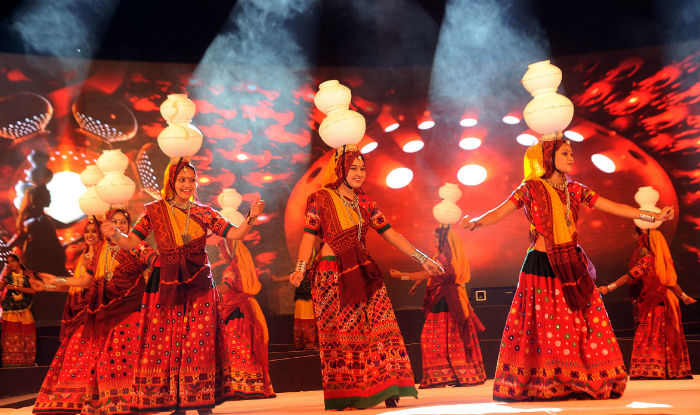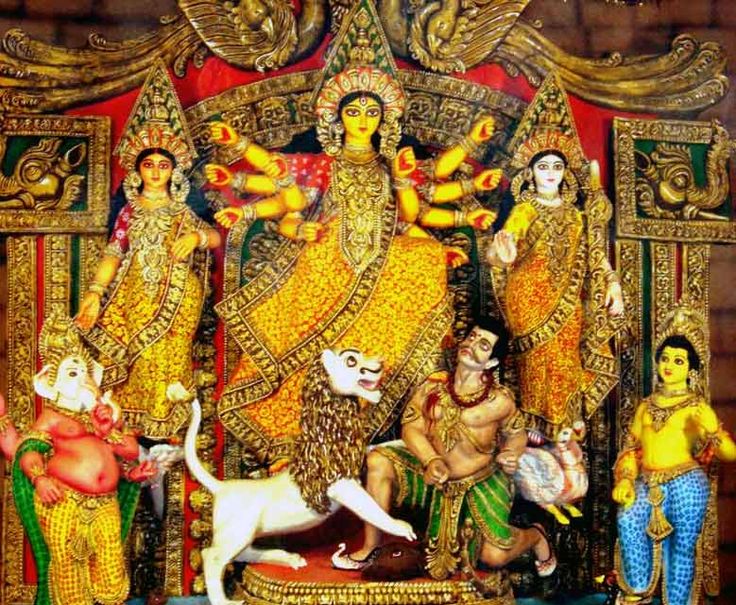The beginning of spring and of autumn are two very important junctions of climatic and solar influence. During this period Earth is relatively much near to Sun facing its maximum gravitational pull. It is believed that during this phase, the divine energy intervenes with extra power to pass earth this course with much ease and smoothness. As per Hindu mythology, this divine energy is- Goddess Durga. The Navratri in this context is also celebrated as thanksgiving festival to Goddess Durga for saving, protecting and nurturing life on Mother Earth.
During these days people usually avoid taking meat, fish, eggs, alcohol, onions, garlic, grains, lentils, legumes (beans) because special divine energies of empowerment are not able to reach the individual. In addition, these food items act as a barrier in radiating energy in any form. Further, these tend to accumulate and process free-floating negative karmic energies from other living beings and the environment.
The nine rupa’s of Durga -Shailputri, Brahmcharini, Chandraghanta, Kushmanda, Skandmata, Katyaini, Kaalratri, Mahagauri, and Siddhatri represents different traits of human beings such as Smiriti, Shraddha, Lajja, Hunger, Thirst, Forgiveness, Luster, Beauty, Sight, Truth etc. These also control various systems and organs of human body. So everything related to human mind, psychology and body are controlled and maintained by these nine forms of divine energy. During nine days of Navratri By worshiping a particular form of Durga one is blessed with different physical, mental and psychological strength.
Significance of Nine Days of Navratri
1st Day of Navratri – The first night of Navratri is devoted to the worshiping of Goddess Shailputri. She has the manifestation of Green Light with her. This light helps to reduce anger in Human beings. This energy manifests in Anahata or Heart chakra. The organs related to this chakra are the heart, back, shoulder, arms, hand, Lungs and Chest area. The gland associated with this chakra is Thymus gland. This chakra relates to Love, an ability of an individual to give and take unconditionally. It enhances listening capability of individuals. Thus meditating on this chakra help in removing emotional blocs, treating traumas and healing of diseases related to concerned organs, glands, and system efficiency. This is the starting point of their spiritual discipline.
2nd Day of Navratri – The second night of Navratri is associated with Goddess Bhramcharni, who is the storehouse of knowledge and wisdom. She has the manifestation of Blue Light with her that personifies love and loyalty and empowers actualization of goals. The organs related to this chakra are throat, lung, and neck. The gland associated with this chakra is thyroid gland. The upper digestive tract is also associated with this chakra. This energy resides in Visudha or Throat chakra. It blesses the worshipper with awareness about the spirit of truth and purpose, ability to communicate about one’s needs and requirements. It also helps in healing of diseases related to concerned organs, glands, and system effectively.
Visiting Maa Vaishno Devi’s temple on Ashtami during Navratri is considered highly auspicious.
3rd Day of Navratri – The third night of Navratri is associated with Goddess Chandraghanta who is a giver of bliss, peace, serenity, and growth in activities, the purpose of life. She has the manifestation of red light with the pink hue in her. Residing in Mooladhar or root chakra this energy provides the worshiper with powers of self-awareness, stability, and security. The organs related to this chakra are Kidney, bladder, pelvis, vertebral column, hips, and legs. The gland associated with this chakra is an Adrenal gland. The system associated with this chakra is an excretory system. It provides strength and courage to native. With this, It also helps in healing of diseases related to concerned organs, glands, and system effectively.
4th Day of Navratri – The fourth night of Navratri is associated with Goddess Kushmanda who is destroyer sorrows of the mind and ego by harmonizing the macro-universe with the inner micro-universe of the individual. She has the manifestation of Orange Light with a golden hue that personifies creativity and respect for others creative works, destroying false ego in an individual. The organs related to this chakra are the uterus, large bowel, lower abdomen, ovaries, testes, sexual organs. The reproductive system is also associated with this chakra. This energy resides in swadhisthan or Sacral chakra. It endows the worshipper with the virtue of Self-respect. It also helps in healing of diseases related to concerned organs, glands and system effectively
5th Day of Navratri – The fifth night of Navratri is associated with Goddess Skandmata who transform energies provided by other goddesses in form of wealth and strength for native. She has the manifestation of indigo light with the silver hue. The organs related to this chakra are eyes, lower head, nose, and ears. Pituitary Gland is also associated with this chakra. Residing In Agya or Brow chakra this energy provides the worshiper with the virtue of self-responsibility- responsibility to oneself to follow the soul path and trusting one’s own intuition. It also helps in healing of diseases related to concerned organs, glands and system effectively
6th Day of Navratri – The Sixth night of Navratri is associated with Goddess Kaatyayani who gives boons and fulfills wishes of the native. She has the manifestation of Yellow Light with her that personifies self-worth, intellect, self-confidence and moral principles. The organs related to this chakra are liver, spleen, stomach and l intestine gallbladder and middle back. The gland associated with this chakra is Pancreas. This energy resides in Manipur or Solar plexus chakra. It endows the worshipper with the virtue of how one feels about himself and how others perceive him. It also helps in healing of diseases related to concerned organs, glands and system effectively
7th Day of Navratri – The Seventh night of Navratri is associated with Goddess Kaalratri who destroys fear and ignorance of the worshiper and blesses the individual with fortitude and fearlessness. She has the manifestation of violet light with purple-blackish hue. The organs related to this chakra are Top of the head, brain and Nervous System. The gland associated with this chakra is pineal Gland. Residing in Crown chakra this energy provides the worshiper with higher consciousness or spiritual awareness. It helps in the spiritual upheaval of individual Atma with Parmatma. It also helps in healing of diseases related to concerned organs, glands and system effectively
8th Day of Navratri – The eighth night of Navratri is associated with Goddess Mahagauri who destroys all sins of devotees and worshiper gets purified in all respects. She channels the thought waves of the devotees towards the path of the virtue and destroys Asat. Cumulative energy manifested in the whole body and being reflected signifies balance and creativity in the highest form.
9th Day of Navratri –The ninth night of Navratri is associated with Goddess Siddhidatri who provides the worshiper with all sidhis, beings fulfillment and satisfaction in individual lives. This energy is radiant in form of golden light over crown chakra instilling service to God and libration of a soul from the vicious circle of life and death.
Kanya or Kumari Pujan During Navratri’s
During navratris, Kumari or Virgin girl is worshipped for nine consecutive days. A Kumari is a symbol of un-manifested energy and by worshipping her, this energy gets activated as a result of which radiant frequencies in the universe get attracted and worshipers get benefited by it. The Hindu scripture- Rudryamla Tantra, has categorized girl into different age groups for worshiping the goddess. The result of boons begetted differs for each Kumari Pujan.
A one-year-old girl is called “Sandhya”, two years old is called “Saraswati”, three years old is called “Tridhamurthy”, four years old girl is called “Kalika”, five is “Subhga”. At six, she is “Uma” at seven, she is called “Malini” and “Kubja” in her eighth year. She is “Kaalsandharbha” in nine, “Aparajita” in ten and “Rudrani” in eleven years of age. A girl in the twelfth year is “Bharavi” and “Mahalaxmi” in thirteenth. In her fourteen, fifteen and sixteenth year, she is known as “Peethnayika”, “Chetraja” and “Ambika” respectively.
The significance of three claps during Garba or Kanya Pujan:
It is believed that divine energy is awakened by the musical rhythm of three claps through the frequencies of desire, action, and knowledge, representing the Brahma, Vishnu, and Mahesh. It also signifies awakening of fire element
With the first clap, Lord Brahma energy of desire gets awaken. This energy signifies wishes in mind of an individual
With the second clap Lord Vishnu energy related to action get awaken. This energy signifies actions performed by individual for fulfillment of desires.
With the Third clap, Lord Shiva energy related to begetting results get awaken. This energy signifies boons given by God to Individual.
On each day, I shall post one article about each of the 9 manifestations of Goddess Durga. 🙂 Look out for the space to know more.


